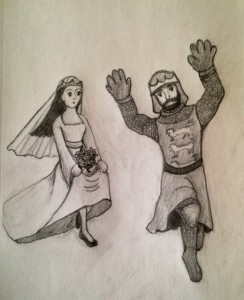Wedding Announcements
Posted in General, On This Day on May 12th, 2015 by Eugene Finerman – 2 CommentsMay 12, 1191: Richard the Lion-Heart Marries Berengaria of Navarre
 We are still waiting for the marriage to be consummated. Richard evidently was unfamiliar with the adage “Politics makes straight bedfellows.” In fairness to Richard, he never misled that poor Spanish princess. His mother did. Eleanor of Aquitaine was worried that her 33 year old son had yet to marry. He was King of England, a hereditary position, and heredity usually requires a certain physical exertion. His younger brothers were married–even the gnomish John. (Yes, his bride was the unwilling one.) So Eleanor was determined to get her favorite son a wife.
We are still waiting for the marriage to be consummated. Richard evidently was unfamiliar with the adage “Politics makes straight bedfellows.” In fairness to Richard, he never misled that poor Spanish princess. His mother did. Eleanor of Aquitaine was worried that her 33 year old son had yet to marry. He was King of England, a hereditary position, and heredity usually requires a certain physical exertion. His younger brothers were married–even the gnomish John. (Yes, his bride was the unwilling one.) So Eleanor was determined to get her favorite son a wife.
On parchment (paper had yet to be imported from China), Richard would have seemed a great catch. He was King of England and Duke of half of France: you had to go to Constantinople to find a Christian boy with a better resume. Furthermore, Richard was handsome and chivalrous. What more could a princess want? Well, yes, apparently the princesses of France and Germany had heard about “that”. But the royal family of Navarre either hadn’t or couldn’t afford to be choosy. The smallest, most precarious kingdom in Spain could use the butchest son-in-law in Christendom, and so Berengaria’s troth was really plighted.
Richard, who had no compunction about trying to kill his father, somehow couldn’t disobey his mother. All right… he would get married, but he wasn’t making it easy. First, they had to find him. Richard was off to the Crusades. His last known address was Messina, Sicily. So his 69 year-old-mother, with Berengaria in tow, arrived there in March, 1191. Fortunately, Richard was still in Sicily but it was during Lent, and he wouldn’t think of getting married then. But rather than wait a few weeks, Richard now was in a hurry to get to the Holy Land. After all, there were Moslems and Jews waiting to be killed, along with any unfortunate Greek Orthodox bystanders. However, if Berengaria was willing to tag along, Richard would find the time to marry her. Perhaps, after he captured Jerusalem…or Mecca.
Eleanor no longer had the patience or stamina to goad Richard to the altar. She returned to France, but Richard had not completely escaped the chiding females of his family. The dowager queen of Sicily happened to be his sister Joan, and she was quite prepared to organize a wedding in the Holy Land. When Richard set sail, Joan and Berengaria weren’t far behind. A storm struck the fleet, however, and the ship carrying the theoretical bride and the aspiring matron of honor was driven off course to Cyprus. There the Byzantine governor–demonstrating why his cousin the Emperor wouldn’t trust him in Constantinople–attempted to seize the royal women for ransom. Of course, the chivalrous Richard had to rescue the two damsels in distress. He incidently conquered Cyprus, too. (The Byzantines would never get it back.) What happened next defies explanation but would make a wonderful ad for Cypriot Tourism: Cyprus–where even the unwilling get married! Yes, on this day in 1191, Richard succumbed to formality.
Berengaria went along on the Crusade, perhaps mistaking it for a honeymoon, but soon decided to return to Europe. At least, she now had the expense allowance befitting a queen. France could be very comfortable for the rich and, of course, who could blame her for dropping by Navarre to flaunt her position. Ironically, Berengaria never visited Britain, the only Queen of England with that unique omission. (Of course, Richard was rarely there, either: six months out of his ten year reign.) The King and Queen had a platonic marriage; in fact, they rarely saw each other. The Pope felt compelled to advise Richard on marital duties. In similar circumstances other women might have succumbed to therapeutic sins, but Berengaria never did. She evidently was saving herself for Richard.
He died in 1199: a minor arrow wound but a very bad doctor. The widow was in her thirties, but she never was interested in a second–or real–marriage. Indeed, she would eventually join a convent. As Mrs. Plantagenet, she already had eight years practice as a nun.